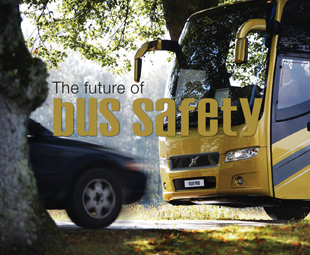The future of bus safety

Passive safety technology can greatly decrease the severity of road accidents. New active safety technology, however, can assist in preventing accidents altogether.
Consider the following. Traffic on European roads has increased three-fold over the past 30 years, yet the number of road-related fatalities has actually been halved.
How is it possible that traffic can increase so much, yet fatalities decrease? Technological developments like seatbelts, airbags and crumple zones have made vehicles much safer. Accidents that would have resulted in fatalities a decade or two ago are suddenly survivable, owing to the safety features found in modern vehicles.
But reducing the damage caused by an accident isn’t enough. The ideal would obviously be to prevent accidents altogether. And nowhere would the prevention of accidents be more significant than in the arena of public transport. Owing to the number of people that travel on a bus or coach at one time, an accident can have disastrous consequences. If these accidents could be prevented, the number of lives saved would be significant.
It might seem fantastical to suggest that technology might reach a level where accidents could be avoided totally, but recent developments suggest that this might become a reality sooner than expected.
“We’ve made significant progress in technology in recent years. In the longer term, it is fully realistic to have a vision for zero accidents,” says Carl Johan Almqvist, the traffic and product safety director at Volvo Trucks.
Volvo has long been an industry leader in passive safety – or technology that protects the vehicle’s occupants in an accident. In recent years, the company has also taken the lead in the sphere of active safety, which helps the driver avoid accidents. In 2008, Volvo launched safety systems that are unique in the industry and that prevent two of the most common causes of accidents: drowsiness and inattentiveness.
Indeed, many accidents are preventable and are often attributable to driver error. Because of this, it is important that drivers be monitored and notified if they do something that puts passengers in danger. If a dangerous action is identified before an accident occurs, the likelihood of preventing that accident increases dramatically.
“The key problem with bus and taxi drivers is that their driving habits are not monitored closely enough, simply because they have no one driving with them to do this and assist in driving skills development,” says Louis Swart, managing director of Drive Report, a local company specialising in driver behaviour improvement. “As a result, bad driving habits become part of the driver’s routine, making every trip an increasingly risky endeavour.”
Drive Report is the South African agent for DriveCam, an in-vehicle video camera that records erratic driving incidents in the form of 12-second clips which are transmitted to fleet controllers, enabling them to implement corrective coaching before major accidents occur.
“The DriveCam event recorder, which links to driver-profiling software, has proven itself the world over to dramatically reduce collisions while enhancing driver skills,” Swart explains. “The camera is not a surveillance tool because it doesn’t record constantly, but by exception, showing eight seconds before the event occurred and four seconds thereafter, giving a clear account of what actually happened.”
The reason behind the success of the system is simple: drivers who know that there will be a recording of their mistakes are far less likely to be inattentive and therefore less likely to cause an accident. But what about those situations where there is nothing that a driver can do to avoid an accident? After all, the driver isn’t always in the wrong. Sometimes other factors are to blame.
Thankfully, however, technology might soon be available that won’t just monitor drivers, but also actively assist them in preventing accidents.
According to Volvo, the vehicle of the future will have a digital co-driver on board; a virtual guardian angel that assists – or even takes over – if the driver loses control. The company is part of the European Union’s Highly Automated Vehicles for Intelligent Transport (HAVEit) project, which is focusing on creating next-generation intelligent vehicles that can save lives and the environment through the development of advanced driver-assistance systems. The HAVEit project has €28 million (R312 million) at its disposal and the aim is to develop a sort of virtual co-driver that responds to the current traffic situation and the driver’s needs.
“One of the challenges is how the vehicle should communicate with the driver, what sort of displays, voice functions and so on it should have. We all have different temperaments, so the system must recognise when the driver is feeling irritated or calm,” says Reiner Hoeger, project coordinator for HAVEit.
This technology relies on a number of sensors on the outside of the vehicle that respond to the traffic environment, scan lane markings, road signs, the current traffic situation and the road conditions. This is combined with an internal system that monitors the driver and interprets their needs. What’s more, the truck is enhanced so that it can all be controlled electronically. The same technology will also help make the vehicles more economical and help the driver drive in a more environmentally favourable way.
“We are not trying to make the driver superfluous,” explains Hoeger. “We want the driver to always have some form of control. We do this through continuous dialogue between the driver and the system, where the vehicle becomes more or less automated depending on the current circumstances.”
Another big step in technological development is a system that makes vehicles more intelligent by, for instance, communicating with one another and with the surrounding traffic. In the longer term, these vehicle-to-vehicle (V2V) and vehicle-to-infrastructure (V2I) systems can pave the way for technology where two oncoming vehicles can, for example, “converse” with each other and avoid a frontal collision if the drivers fail to react.
“The idea is to give the driver advanced relevant information about what is happening on the roads, based on data about the position and speed of other vehicles, road conditions and any obstacles there might be on the route. In order for this to function safely, it is necessary to have reliable and quick communication in a local network,” says Almqvist. “This type of technology must be exceptionally reliable and requires open, constructive collaboration between vehicle manufacturers and society. One of the main challenges is to find a standardised ‘language’ for vehicle-infrastructure communication.”
Of course, it will take some time before this technology becomes freely available, but great strides are being made. The on-board monitoring systems already being used are just the first step in the development of active safety technology that will allow drivers to prevent accidents altogether.
Published by
Focus on Transport
focusmagsa



